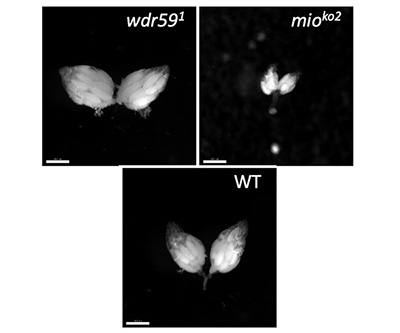
Fruit fly ovaries lacking Wdr59 (wdr591) are large, while ovaries lacking a critical GATOR2 component (mioko2) are small, reflecting that Wdr59 is required to inhibit growth and the GATOR2 component Mio promotes growth. Typically sized ovaries (WT) are shown for comparison. Credit: Lilly Lab, NICHD
The protein complex TORC1 controls cell growth in organisms from yeast to humans. Improper regulation of TORC1 activity contributes to many human diseases, including epilepsy and cancer. The GATOR protein complex is an important regulator of TORC1 and its response to the presence of nutrients in the cell. GATOR comprises two subcomplexes. GATOR1 inhibits TORC1 activity, while GATOR2 blocks the activity of GATOR1 and thus activates TORC1.
Studies in fruit flies, or Drosophila, by the Lilly Lab revealed that the protein Wdr59 functions as an upstream inhibitor of GATOR2. Based on cell culture experiments, scientists had previously thought that Wdr59 was a key part of the GATOR2 complex. In contrast, the NICHD researchers’ work indicates that that Wdr59 is not an obligate member of GATOR2 and shows that GATOR2 can inhibit GATOR1 independent of Wdr59.
The researchers found that in certain Drosophila tissues, such as the ovary, Wdr59 blocks TORC1 activity by blocking GATOR2’s inhibition of GATOR1. In some other Drosophila tissues and in cell cultures, however, Wdr59 promotes TORC1 activity. Further experiments revealed that in these contexts, Wdr59 protects GATOR2 from destruction by the cell’s protein-breakdown machinery, thus promoting TORC1 activity.
Their results identify a novel function for Wdr59 and offer new insights into how GATOR regulates TORC1 activity. This knowledge will aid efforts to develop drugs that act on GATOR-TORC1 signaling to treat diseases ranging from cancers to neurological disorders. The findings also highlight the importance of studying cell signaling in the appropriate context.
Learn more about the Cell and Structural Biology Group: https://www.nichd.nih.gov/about/org/dir/affinity-groups/CSB
 BACK TO TOP
BACK TO TOP